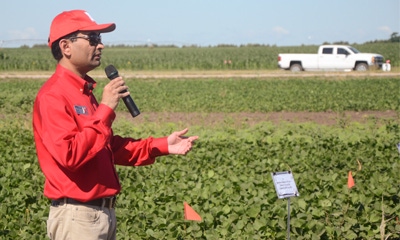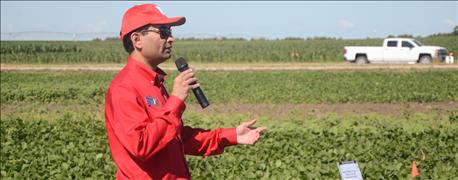
Amit Jhala calls it the future of weed control. "Right now we aren't seeing any brand-new herbicides with new modes of action. I don't think we will it in the next five years or so," says Jhala, University of Nebraska-Lincoln Extension weed management specialist. What growers do have coming to the market are new crops tolerant to multiple herbicides. "Now, our industry is seeing more business in seed. More and more pesticide companies are turning into seed companies," he says.

FUTURE OF WEED CONTROL: Amit Jhala, Nebraska Extension weed management specialist, discusses several new varieties of multiple-herbicide-tolerant soybeans at a field day in late June at UNL’s South Central Agricultural Lab near Clay Center. Multiple-herbicide-tolerant crops are what he calls the "future of weed control."
At a recent Weed Management Field Day at the South Central Ag Lab near Clay Center, Jhala discussed the potential new multiple-herbicide-tolerant soybeans have in the war on weeds — especially herbicide-resistant weeds.
"We have about 2.5 million acres in Nebraska infested with glyphosate-resistant common waterhemp. Marestail is similar — about 2.5 million acres are resistant," he says. "If you combine those two weeds, we have 5 million acres in eastern Nebraska infested with glyphosate-resistant marestail and glyphosate-resistant common waterhemp. Glyphosate-resistant kochia is infesting more than 2 million acres in the western part of the state."
That's where these new multiple-herbicide-tolerant technologies come in. Jhala discussed herbicide programs and crop safety in several of these technologies, and their effectiveness in controlling weeds like common waterhemp, marestail and Palmer amaranth. This includes Monsanto's Roundup Ready 2 Xtend soybeans with tolerance to dicamba plus glyphosate; Dow AgroSciences' Enlist soybeans with tolerance to glyphosate plus 2,4-D choline; Bayer Crop Science's Balance Bean soybeans with tolerance to Balance (isoxaflutol) and Liberty; and DuPont's Bolt soybeans with tolerance to glyphosate plus ALS-inhibiting herbicides, such as Basis Blend.
"Soybeans are very sensitive to 2,4-D and dicamba, but seed companies are now looking at products tolerant to 2,4-D or dicamba, and we can use these products upon commercialization of Roundup Ready 2 Xtend and Enlist soybeans," Jhala says. "It will provide one more control option for postemergence control of glyphosate-resistant weeds."
With Balance Bean, growers have access to a soybean that's tolerant to a preemerge herbicide — Balance Flexx. Because Balance Bean soybeans are tolerant to Balance (isoxaflutol) as well as Liberty, Liberty can be followed up as a post. Although it isn't foliar-active, Balance can also be applied postemerge when tank-mixed with Liberty to provide foliar activity and additional residual activity, Jhala notes. It can also be tank-mixed with other preemerge herbicides to improve the overall weed control spectrum.
"It also reduces the chances of any herbicide-resistant weed species to evolve," Jhala explains. "When you tank-mix two to three herbicides together, the chances of resistance evolving are reduced significantly."
When using other new multiple-herbicide-tolerant soybeans like Enlist or Roundup Ready 2Xtend, which are tolerant to postemergence herbicides, it's important to use preemerge herbicides with multiple modes of action followed up with a single post, Jhala notes.
"Preemergence applications will still be very effective with any soybean variety — whether Roundup Ready 2Xtend, Enlist, Bolt or Balance Bean soybeans. Preemergence applications with multiple modes of action are the foundation for weed control in soybeans," he says. "When we use only a postemergence application, our options are very limited."
With those 5 million acres of glyphosate-resistant weeds in Nebraska, it's important to prevent resistance from developing to dicamba or 2,4-D. "Glyphosate is an excellent herbicide, but I think we applied it too much in the last 20 years," Jhala adds. "If we aren't careful, you may have weed species that are also resistant to 2,4-D, dicamba or Liberty. You would lose all these brand-new tools coming to the market. Therefore, an integrated weed management approach is needed."
About the Author(s)
You May Also Like






